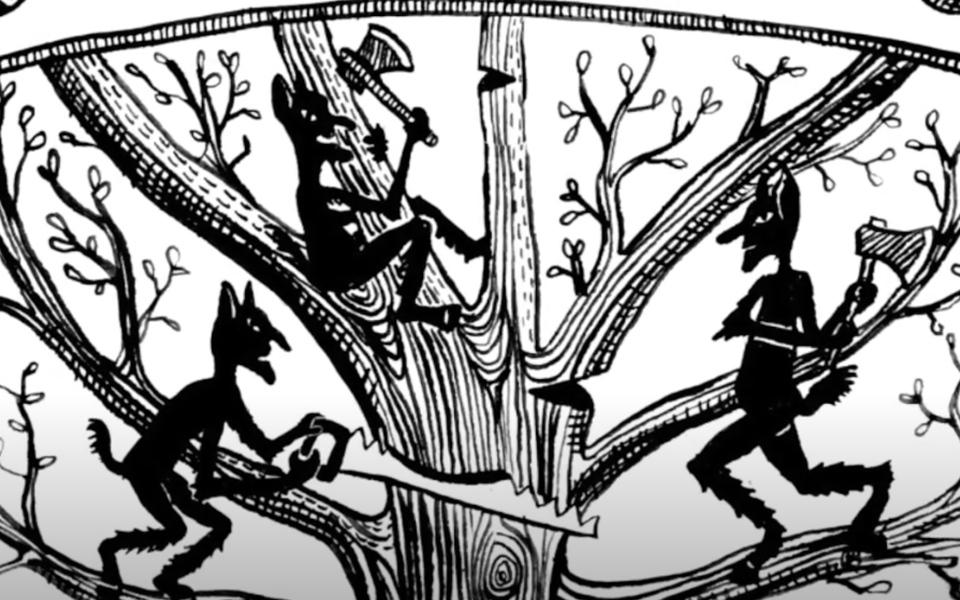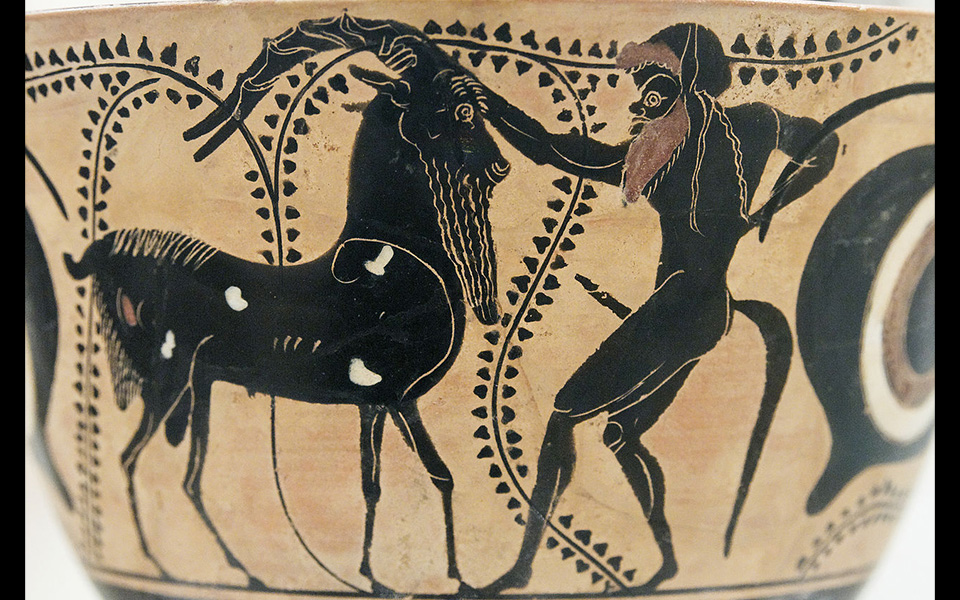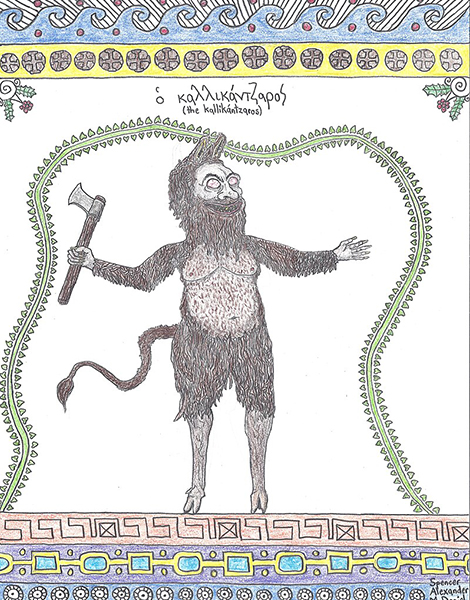As Christmas casts its shimmering glow over bustling streets and houses draped in twinkling lights, a query lingers within the winter air: Have you ever seen unusual noises at night time, like faint scratching or low murmurs from unseen sources? Or maybe you’ve woken to an inexplicably upturned chair, an extinguished hearth, or the faint scent of one thing otherworldly? Beware – your festive season is probably not as peaceable as you suppose.
You may need had an uninvited customer – a mischievous little goblin often known as a “Kallikantzaros” (plural: “Kallizantzaroi”). These supernatural creatures from Greek folklore awaken through the Twelve Days of Christmas, bringing with them a peculiar mix of mischief, mayhem, and darkish humor. Their antics remind us that even within the season of pleasure, shadows nonetheless linger on the edges of the sunshine.
Let’s dive into the fascinating world of the Kallikantzaroi to uncover their origins, well-liked tales, and the methods they proceed to form Greek Christmas traditions.

The World Tree and Everlasting Mischief
The story of the Kallikantzaroi begins within the deep, myth-laden roots of Greek folklore. Students hint their lineage to historic beliefs in chthonic spirits – malevolent beings thought to inhabit the underworld and emerge through the darkish days of the winter solstice. This era, when the solar’s mild wanes, was thought of a time of heightened supernatural exercise.
As Christianity unfold by Greece, pagan customs merged with Christian traditions, remodeling these spectral figures into the Kallikantzaroi we all know at present. The Twelve Days of Christmas – referred to as the “Dodekaimeron” in Greek – grew to become their playground. From December 25 to January 6, these goblins abandon their subterranean properties to roam villages and cities, leaving chaos of their wake.
Based on folklore, the Kallikantzaroi spend a lot of the 12 months deep underground, laboring to noticed by the trunk of the legendary World Tree – a cosmic pillar believed to help the Earth. This Sisyphean process isn’t accomplished, because the goblins are compelled to ascend to the floor through the Dodekaimeron. Whereas they revel of their seasonal escapades, the World Tree miraculously heals, forcing the goblins to start out anew once they return to their underground lair after Epiphany. The futility of their efforts echoes the themes of cyclical time and perpetual battle discovered all through Greek mythology.

The time period “Kallikantzaroi” sparks energetic debate amongst folklorists. Some hint it to the Greek phrases “kalos” (that means lovely) and “kantharos” (beetle or pot), hinting at a mixture of magnificence and grotesqueness. Others hyperlink it to “kalos-kentauros” (lovely centaur), evoking the comically hideous satyrs of historic Greek mythology, companions of Dionysus, the god of wine and revelry.
Whereas related goblins seem within the folklore of different neighboring cultures – like the dreaded (and considerably extra terrifying) Krampus of Alpine custom – the Kallikantzaroi stay uniquely Greek, entwined with the nation’s wealthy tapestry of Christmas customs.

© Katolophyromai

Bodily Look and Traits
The Kallikantzaroi are as bizarre and grotesque as they’re fascinating. Think about small, hunched figures with coarse, bushy pores and skin, goat-like legs, and sharp claws that gleam within the firelight. Their glowing eyes pierce the darkness, and their twisted, animalistic options give them a really otherworldly look. Some tales describe them as lisping and blind, with a penchant for feasting on worms, snails, and different unappetizing creatures.
But for all their fearsome seems, the Kallikantzaroi are extra prankster than predator. They enjoyment of petty mischief. Their favourite actions embrace souring milk in village properties, extinguishing fires, and spilling ash from hearths throughout freshly cleaned flooring.
They’re mentioned to slide into homes by chimneys, cracks in partitions, and even open home windows. Their antics, although irritating, are not often dangerous, incomes them a fame as impish nuisances quite than malevolent beings.

Legends and In style Tales
Probably the most iconic story of the Kallikantzaroi is their futile endeavor to fell the World Tree, thus inflicting the Earth to break down in on itself. This narrative, with its cyclical rhythm, captures the essence of their existence: creatures doomed to an everlasting dance of toil and frivolity.
One beloved Greek fairy story in regards to the Kallikantzaroi recounts the story of two sisters, Kallo and Marbo. Within the story, Kallo is shipped to the mill at midnight and encounters the goblins. Utilizing her wit, she tips them into fetching her jewels and exquisite clothes. By daybreak, the goblins are pressured to retreat, leaving Kallo unscathed and richly adorned. Marbo, envious of her sister’s success, makes an attempt the identical however lacks Kallo’s crafty. As an alternative, she falls sufferer to the goblins’ pranks, returning residence humiliated.
This story highlights the twin nature of the Kallikantzaroi: harmful but prone to human crafty.

© Shutterstock
Function in Greek Christmas Traditions
In Greece, the Twelve Days of Christmas are celebrated with a mixture of pleasure and warning. This era, spanning from December 25 to January 6, is sometimes called the “unbaptized days” in Christian custom – the time from the Nativity to the go to of the Magi, or Three Kings. The Kallikantzaroi are believed to be most energetic throughout this era, resulting in a spread of customs and rituals aimed toward warding them off.
A favourite amongst Greeks is to hold garlic at entryways, its pungent scent believed to repel the goblins. One other fascinating customized includes leaving a colander by the door. Based on legend, the Kallikantzaroi are compelled to rely the holes within the colander, however their incapacity to rely past two – three being a sacred quantity – ensures they’re caught on this futile process till the primary rays of daybreak chase them away. Different customs embrace lighting fires in hearths all through the Dodekaimeron to forestall the goblins from getting into by chimneys and drawing crosses with charcoal on doorways for non secular safety. In some areas, households cling a basil-wrapped cross over a bowl of holy water, utilizing it to bless every room every day.
Meals performs a central position in Greek Christmas traditions, and even the Kallikantzaroi have discovered their place on the desk. Households typically pass over choices of “loukoumades” – golden, honey-soaked doughnuts – as a distraction for the goblins, who’re drawn to their sweetness.

© Shutterstock
Because the Twelve Days of Christmas draw to an in depth, the Feast of Epiphany on January 6 brings a climactic finish to the goblins’ antics. This present day holds profound non secular significance within the Greek Orthodox Church, commemorating each the Magi’s go to to the toddler Jesus and His baptism within the Jordan River. On Epiphany morning, clergymen bless properties and public areas with holy water, banishing the Kallikantzaroi again to their subterranean lairs.
In some areas, younger males take part in the “Blessing of the Waters,” diving into icy rivers or seas to retrieve a cross thrown by the priest, symbolizing purification and renewal. For a lot of Greeks, this marks not solely the goblins’ departure however a non secular reset – a return to order after the chaos of the unbaptized days.
Kallikantzaroi in Fashionable Tradition
Whereas perception within the Kallikantzaroi has light in city areas, they continue to be a beloved a part of Christmas folklore in lots of components of rural Greece. Tales in regards to the goblins are handed all the way down to youngsters, fostering a connection to cultural heritage, and offering playful classes about penalties and conduct. Native theater performances and festive decorations typically characteristic these mischievous creatures, including humor and whimsy to the festive celebrations.
Newer interpretations of the Kallikantzaroi typically painting them as misunderstood outcasts quite than outright villains, including depth to their character. This mirrors broader tendencies in folklore, the place historically fearsome figures are reimagined as advanced, relatable entities.
Past their antics, the Kallikantzaroi symbolize the strain between chaos and order, darkness and lightweight. They replicate humanity’s need to elucidate the unknown and discover steadiness in a world stuffed with each mischief and surprise.
So, as you mild your fireside and cling your garlic this Christmas, keep in mind the Kallikantzaroi and the magic they convey to Greece’s winter nights. Mischievous but endearing, these goblins are a testomony to the enduring energy of folklore, connecting generations by tales of laughter, surprise, and festive mischief. Who is aware of? They may pay you a go to this vacation season – however just for a innocent prank or two.



Recent Comments